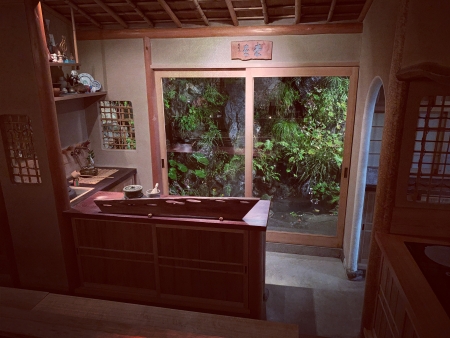非日常のなかの日常
「気分」を受け止める建築の例として茶室を出したが、茶室を思い浮かべる時、内部空間しか出てこない。
外観があるはずで、躙口は思い浮かぶのだが、それだけである。離れになっていれば外観はあるはずで、しかし、茶室の場合、母屋に附属した部屋であったり、単に室内の一部が茶室のような設えになっていることもあるので、明確な外観が無い場合もあるからかもしれないが、露地は思い浮かぶ。
ただ、露地は外部空間だが、内部空間の延長にある、待合の意味合いに近いような気がするので、どうしても内部空間に含めて連続的に解釈をしたくなる。
非日常を日常のように味わう工夫があると思う。それは、茶室での体験は特別で非日常なのだが、日常の中で感じることや想うことや、それこそ気分などを、より先鋭させ、意識的にさせてくれるから、素は日常にあるから、茶室で感じたり、想ったりすることに親近感があるというか、そこに誰でも自分の解釈で読み取る余地、余白があり、自分なりの物語を紡ぎ出すことができるので、お茶会に一方的に参加させられている感は無く、その場をつくり出す一員になっている気にさせてくれるからかもしれない。
茶室の建築は、それこそ教科書に出てくるような、今さら目新しさもなく、素晴らしいのはわかっているのだが、「気分」を持ち出して考えれば、また違った見え方や「気分」を受け止める建築のヒントになるのではないかと考えている。特に内部空間の設えの有る無しの差が気になる。
ただ、いわゆる茶室という形式の強さみたいなものが前面にあり、その本質の、日常と気分と設えの関係性がなかなか見えてこない。もう少し意識して考えてみたい。
"Daily life in extraordinary life"
As an example of architecture that catches "feeling", a tea room was set up, but when you think of the tea room, only the internal space comes out.
There should be an appearance, and Higuchi comes to mind, but that's it. If it is separated, it should have an appearance, but in the case of a tea room, it may be a room attached to the main house, or just a part of the room may be set up like a tea room, so a clear appearance It may be because there are cases where there is no, but the open ground comes to mind.
However, the open space is an external space, but I feel that it is close to the meaning of waiting, which is an extension of the internal space, so I definitely want to include it in the internal space and interpret it continuously.
I think there is a device to taste the extraordinary like everyday. The experience in the tearoom is special and unusual, but it makes you feel and think in everyday life, and make you feel more sharp and conscious. There is a sense of intimacy in feeling and thinking in the tea room, or there is room for anyone to read in their interpretation, there is a margin, and you can spin your own story, so you can unilaterally attend the tea party It may be because there is no feeling of participation, and it makes me feel like I am a member who creates the place.
The architecture of the tea house is just as it appears in textbooks, and it is not so novel now, but I know that it is wonderful, but if you bring out "feeling" and think about it, it will take a different view and "feeling" I think it might be a hint. In particular, I'm worried about the difference in whether there is an internal space.
However, there is something like the strength of the so-called tearoom in the foreground, and it is difficult to see the essence of the relationship between daily life, mood and setting. I want to think more consciously.

